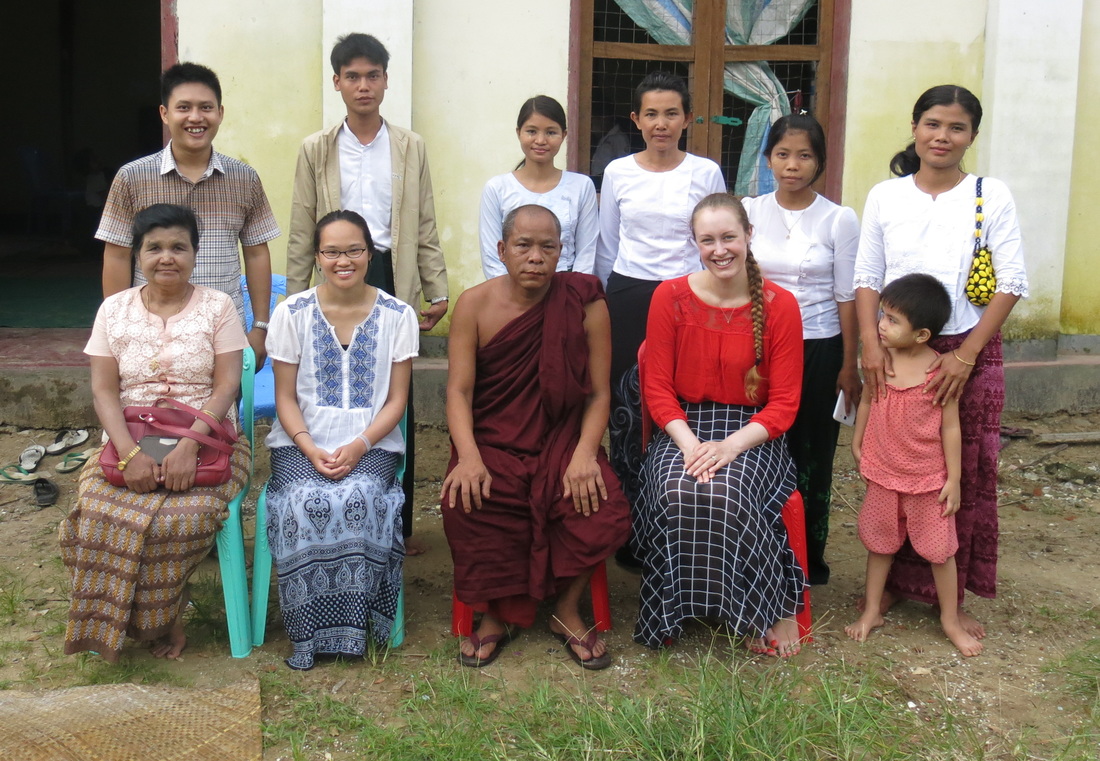|
Today we flew from Yangon to Kyauk Phyu airport. The flight was clean and punctual. We were fed cake from the cool and trendy Parisian bakery cafe in downtown Yangon. There were two types of cake; one was a pound cake and the other was a marble slice with chocolate and vanilla. The air hostesses were dressed impeccably in the traditional outfit of a longyi and matching top. We packed very light as we knew the schedule would involve some smaller modes of transportation as well as potential close quarters for sleeping and living. As we arrived at the airport, we were met by our local guide and ushered through immigration. Everything seemed to go pretty smoothly. Besides us, there were plenty of Chinese workers coming for the oil rigs offshore. We went to the arranged hotel and quickly changed and freshened up for our first Rakhine school visit. Our local guide asked if I was able to drive a scooter; there’s a first time for everything was my reply. Not seeming to find my joke quite as funny as I had, our guide flagged down a local trishaw motorcycle to take us to the monastic school, a 20-minute journey from the hotel. We arrived at a small campus with two buildings; one was where we were received by the head monk. We also met with the local co-ordinator and her mother who was the generous donor for the renovation and creation of new classrooms in the other building we were shown. We met with 4 local teacher, 3 women and 1 man. They were in the middle of lessons when we arrived.  The building was one big room which had the four lessons happening at the same time. Each class from grade 1 through 4 had about 15 pupils seated about a table on the floor. Each teacher had a chair and the back of an upturned table as a chalkboard. On our arrival, the children were quick to rise and yell out a friendly greeting of ‘Mingalabar’ which means auspiciousness to you. It is a greeting which is reserved for foreigners. Local people are much more likely to ask if one has had breakfast or lunch depending on the time of meeting. The majority of the teachers in monastic schools like the one that we visited are students who are still completing their degree or those who have taken the final exams and are waiting for the result. It seems that the exams are mostly taken in October or November and the result is not given until the following April. This gives the young adults plenty of time to aid progression and education in their local communities. Three of the four teachers that we met were students who were teaching part time in addition to their studies. More often than not, there is no money with which to pay these part time teachers, who typically teach from 7-9am before the government school and then again sometimes 4-6pm after government classes finish. The government schools have a set curriculum which teachers must follow. The more traditional teacher-centered approach is generally favored, with students being required to memorize vast amounts of language and facts. Further, the curriculum is focused around Burmese culture, the Burmese ethnicity being the biggest and of the current rulers of the country. However, Myanmar is made up of some 120 ethnic races, with 8 main diverse populations recognized. There is a widely held feeling that the government schools would improve if education was targeted more towards each ethnic group, or at least showed some level of diversity in the history and culture being taught. It is admirable that the young students want to help their communities, and we have been told that English is taught only as a subject, not as a language. By which I have come to understand that they mean speaking is not taught at all, and the only information which is taught is that needed to pass the government set exams. Because of the style of most government schools, and limited access to other means of education, very few of the motivated young students have any form of teacher training. This means that they are very well-intentioned, but find it hard to plan activities or curriculum around which to base their lessons. Without good examples of active, student-centered, task-based learning environments in their own education, it is very hard for the rural teachers we met to dream up such things for use in their own classrooms.
We posed for photos in the evening sun which the children, teachers and head monk before heading back to see the beach sunset on our motorbike trishaw. After the first school visit, we were taken out to eat near the beach by the co-ordinator and her generous donor mother who is very well-liked in the local area! Chloe Smith NEH Coordinator and Teacher Trainer
Comments
|
This section will not be visible in live published website. Below are your current settings: Current Number Of Columns are = 3 Expand Posts Area = 1 Gap/Space Between Posts = 20px Blog Post Style = card Use of custom card colors instead of default colors = Blog Post Card Background Color = current color Blog Post Card Shadow Color = current color Blog Post Card Border Color = current color Publish the website and visit your blog page to see the results |
|
© New Education Highway 2024
Except where otherwise noted, content on this site is licensed under a Creative Commons Attribution 4.0 International License. |


